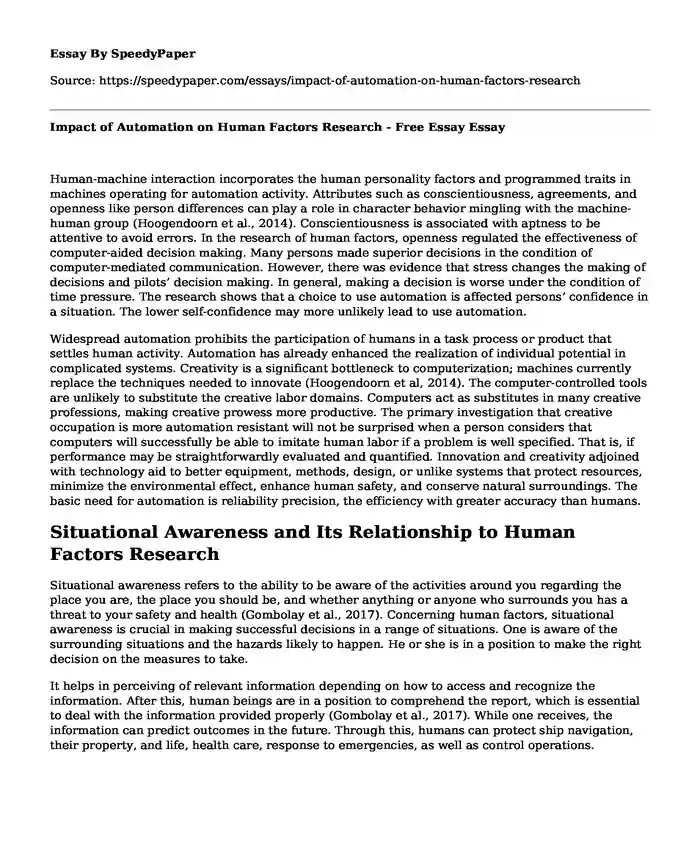
| Type of paper: | Essay |
| Categories: | Technology Human Relationship Stress |
| Pages: | 3 |
| Wordcount: | 792 words |
Human-machine interaction incorporates the human personality factors and programmed traits in machines operating for automation activity. Attributes such as conscientiousness, agreements, and openness like person differences can play a role in character behavior mingling with the machine-human group (Hoogendoorn et al., 2014). Conscientiousness is associated with aptness to be attentive to avoid errors. In the research of human factors, openness regulated the effectiveness of computer-aided decision making. Many persons made superior decisions in the condition of computer-mediated communication. However, there was evidence that stress changes the making of decisions and pilots’ decision making. In general, making a decision is worse under the condition of time pressure. The research shows that a choice to use automation is affected persons’ confidence in a situation. The lower self-confidence may more unlikely lead to use automation.
Widespread automation prohibits the participation of humans in a task process or product that settles human activity. Automation has already enhanced the realization of individual potential in complicated systems. Creativity is a significant bottleneck to computerization; machines currently replace the techniques needed to innovate (Hoogendoorn et al, 2014). The computer-controlled tools are unlikely to substitute the creative labor domains. Computers act as substitutes in many creative professions, making creative prowess more productive. The primary investigation that creative occupation is more automation resistant will not be surprised when a person considers that computers will successfully be able to imitate human labor if a problem is well specified. That is, if performance may be straightforwardly evaluated and quantified. Innovation and creativity adjoined with technology aid to better equipment, methods, design, or unlike systems that protect resources, minimize the environmental effect, enhance human safety, and conserve natural surroundings. The basic need for automation is reliability precision, the efficiency with greater accuracy than humans.
Situational Awareness and Its Relationship to Human Factors Research
Situational awareness refers to the ability to be aware of the activities around you regarding the place you are, the place you should be, and whether anything or anyone who surrounds you has a threat to your safety and health (Gombolay et al., 2017). Concerning human factors, situational awareness is crucial in making successful decisions in a range of situations. One is aware of the surrounding situations and the hazards likely to happen. He or she is in a position to make the right decision on the measures to take.
It helps in perceiving of relevant information depending on how to access and recognize the information. After this, human beings are in a position to comprehend the report, which is essential to deal with the information provided properly (Gombolay et al., 2017). While one receives, the information can predict outcomes in the future. Through this, humans can protect ship navigation, their property, and life, health care, response to emergencies, as well as control operations.
How Flight Simulation Is Used in Human Factors Research and Whether It Has Validity.
In human research factors, flight simulation is used in training pilots to achieve, test, and keep proficiency in an airplane operation without risk to property, person, and at minimizing cost during training in the air (Gould et al., 2012). Flight simulation is no has no validity as there is no system of flight simulator that is realistic. Its systems vary in realism and complexity, with more realistic and complex systems producing the same practical experience for the stimulator's operator. There is a difference over whether attaining training or realism objectives which are essential in simulator development.
The simulator's effectiveness depends on the features' support to the training system. The simulator realism has to vary following task type, type of analysis, and learning stage. The simulator type required in teaching a user to enable him or her to understand the principle of aircraft or flight system varies from the simulator type needed to prepare users on how to demonstrate learning as well as putting the principle into practice (Gould et al., 2012). The technology of simulator and processes must be matched with desired study goals and not developed technologically for its sake
References
Gombolay, M., Bair, A., Huang, C., & Shah, J. (2017). Computational design of mixed-initiative human–robot teaming that considers human factors: situational awareness, workload, and workflow preferences. The International journal of robotics research, 36(5-7), 597-617. https://journals.sagepub.com/doi/abs/10.1177/0278364916688255
Gould, D. A., Chalmers, N., Johnson, S. J., Kilkenny, C., White, M. D., Bech, B., ... & Bello, F. (2012). Simulation: moving from technology challenge to human factors success. Cardiovascular and interventional radiology, 35(3), 445-453. https://link.springer.com/article/10.1007/s00270-011-0266-z
Hoogendoorn, R., van Arerm, B., & Hoogendoom, S. (2014). Automated driving, traffic flow efficiency, and human factors: Literature review. Transportation Research Record, 2422(1), 113-120. https://journals.sagepub.com/doi/abs/10.3141/2422-13
Cite this page
Impact of Automation on Human Factors Research - Free Essay. (2023, Aug 27). Retrieved from https://speedypaper.com/essays/impact-of-automation-on-human-factors-research
Request Removal
If you are the original author of this essay and no longer wish to have it published on the SpeedyPaper website, please click below to request its removal:
- Free Essay Describing Relationship Between Therapist and Client
- Essay Example for You: Tonsillitis, Irritant Contact Dermatitis and Stress
- Comparison Essay Example: ASUS ROG G55VW and MacBook Pro 15-inch screen
- Paper Sample on Sexual Harassment: Violence Against Women Working in Silicon Valley
- Home Visiting and Case Management in Public Health
- Paper Example: Successful Implementation of the Latest Technology Into the K-12 Classrooms
- Paper Example: Healthcare Website Tools
Popular categories




